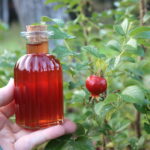Rose Hip Syrup
Rose hip syrup is easy to make with just two main ingredients: rose hips and sugar (or honey, if you prefer!). Whether drizzled over pancakes, stirred into cocktails, or taken as a natural remedy for immune support, this syrup will become your new fall favorite.
Servings: 24 servings (about 1 1/2 cups)
Ingredients
- 3 cups water
- 4 cups fresh rose hips 500 g fresh, or about 1 cup dried rose hips (250 g)
- 1 1/4 cup sugar you can adjust based on your preferred sweetness; if you'd like, you can substitute with honey for a different flavor profile
Instructions
- Prepare the Rose Hips: Start by cutting off the ends of the rose hips (where the flower once bloomed), then rinse them well. You don’t need to remove the seeds or hairy interior, as straining them later will take care of this. If using dried rose hips, skip the rinsing and go straight to the next step.
- Break Them Down: Chop the rose hips into smaller pieces using a knife, or if you have a food processor, pulse them a few times to break them up. This helps to release the juice during the cooking process.
- Simmer the Rose Hips: In a large pot, combine the rose hips with 3 cups (750 ml) of water. Bring to a boil, then reduce the heat and simmer for about 15-20 minutes. You want the water to reduce by at least half and become a rich, concentrated rose hip tea.
- Strain the Mixture: Once the rose hips have softened and the water has reduced, it’s time to strain out the solids. Strain the liquid through a fine mesh sieve lined with muslin or cheesecloth. This is an important step to remove the fine hairs from the rose hips, which can be irritating if consumed. I recommend straining it twice to ensure a smooth, clear syrup.
- Sweeten the Syrup: Add the sugar to the pot with the rose hip liquid, and heat gently over medium heat, stirring until the sugar has completely dissolved. Once dissolved, increase the heat and bring the mixture to a boil. Let it boil for 3 minutes, stirring occasionally. If using raw honey, just stir the honey into the warm rose hip tea, without heating.
- Bottle the Syrup: After boiling, carefully pour the syrup into sterilized bottles or jars. You can store the syrup in a cool, dark place for up to 6 months. Once opened, keep it in the refrigerator for up to a few weeks.
Notes
Fresh rose hips tend to offer a brighter, more vibrant flavor, while dried rose hips will provide a deeper, more concentrated taste. Both fresh and dried hips are great for syrup-making, so choose based on your flavor preference.
Rose hip syrup may thicken over time, especially after refrigeration. If it turns too thick, simply warm it up to return it to a pourable consistency.
If you'd like to experiment with the sweetness, honey can be substituted for sugar. Honey adds a floral, aromatic sweetness that complements the natural tartness of rose hips. Additionally, honey brings its own medicinal properties, including antioxidants and natural enzymes, which may enhance the syrup's immune-boosting benefits. If using honey, simply stir it into the warm, strained rose hip tea — avoid boiling the mixture after adding the honey to preserve its beneficial properties.
For a touch of tang to balance the syrup's sweetness, try replacing part of the water with apple cider vinegar. Up to 1/2 cup of vinegar can be substituted to introduce a pleasant, tangy balance to the syrup, though this is optional and based on your personal taste preferences.
You can also infuse the syrup with spices or herbs to add complexity. Consider adding fresh ginger, cinnamon sticks, or star anise while the syrup simmers. These ingredients will introduce a warming, spicy note, perfect for colder months or when you're looking for an extra layer of flavor.
This recipe is easily scalable based on how many rose hips you have on hand. Simply follow the 3:2:1 ratio: 3 parts water, 2 parts rose hips, and 1 part sugar to maintain the right balance of flavor and sweetness.
Medicinal Use
Rose hip syrup is a natural source of vitamin C, known for its immune-boosting properties. Taking 1–2 tablespoons per day during the colder months can help support the immune system, especially in the cold and flu season.
Culinary Use
Rose hip syrup isn’t just for medicinal use—it’s also a wonderful addition to your kitchen. Drizzle it over pancakes, waffles, or French toast in place of maple syrup for a fall twist. You can also pour it over ice cream, yogurt, or puddings as a sweet topping. For a unique beverage, stir it into hot teas or mix it into cocktails like a gin and tonic or hot toddy for a seasonal, flavorful drink.
Nutrition
Serving: 1Tbsp | Calories: 74kcal | Carbohydrates: 18g | Protein: 0.3g | Fat: 0.1g | Sodium: 2mg | Potassium: 91mg | Fiber: 5g | Sugar: 11g | Vitamin A: 920IU | Vitamin C: 90mg | Calcium: 37mg | Iron: 0.2mg
